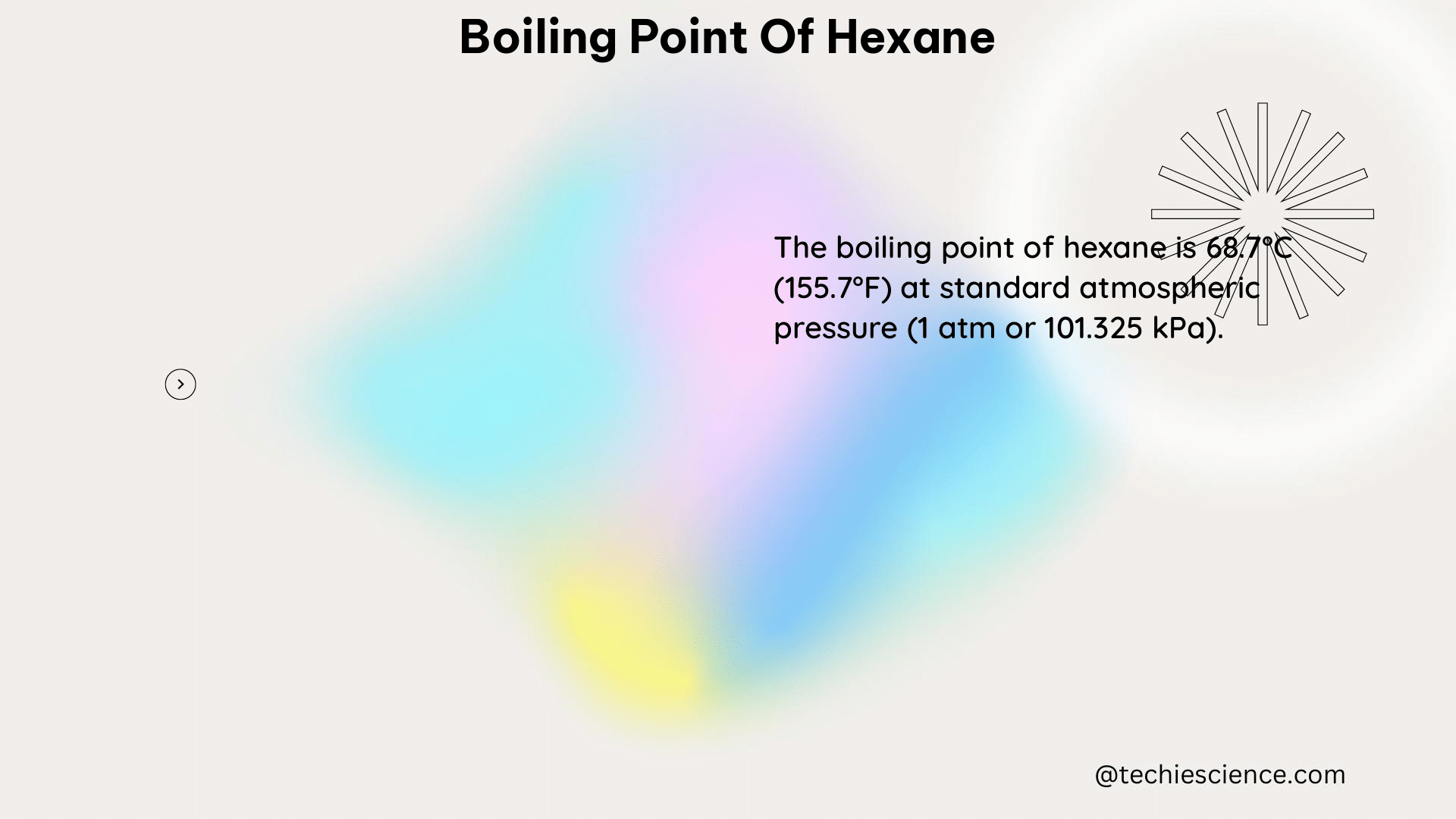The boiling point of hexane, a widely used organic solvent, is a crucial property that has significant implications in various scientific and industrial applications. This comprehensive guide delves into the intricacies of the boiling point of hexane, providing a wealth of technical details and data points to help you understand this important characteristic.
Understanding the Boiling Point of Hexane
Hexane, with the chemical formula C₆H₁₄, is a colorless, flammable liquid that is commonly used as a solvent, fuel, and in the production of various chemicals. The boiling point of hexane is a measure of the temperature at which the liquid-to-vapor phase transition occurs at a specific pressure.
At standard atmospheric pressure (760 mmHg or 1 atm), the boiling point of pure hexane is approximately 68.73°C (155.7°F). This value is widely reported in scientific literature and is considered the standard boiling point of hexane under normal conditions.
Factors Affecting the Boiling Point of Hexane

The boiling point of hexane can be influenced by several factors, including:
-
Pressure: The boiling point of hexane is inversely related to the surrounding pressure. As the pressure decreases, the boiling point also decreases. For example, at a pressure of 500 mmHg, the boiling point of hexane is approximately 64.7°C (148.5°F).
-
Purity: The presence of impurities in the hexane sample can affect its boiling point. Hexane with a higher purity will have a more precise and consistent boiling point compared to a sample with a lower purity.
-
Composition: If the hexane sample is a mixture of different hydrocarbons, the boiling point may differ from that of pure hexane. The boiling point of the mixture will depend on the relative proportions and properties of the individual components.
Measuring the Boiling Point of Hexane
The boiling point of hexane can be measured using various laboratory techniques, including:
-
Distillation: One of the most common methods is to perform a simple distillation of the hexane sample and record the temperature at which the vapor condenses back into a liquid.
-
Vapor Pressure Measurement: The boiling point can also be determined by measuring the vapor pressure of hexane at a specific temperature and then using the Clausius-Clapeyron equation to calculate the corresponding boiling point.
-
Differential Scanning Calorimetry (DSC): This analytical technique measures the heat flow associated with phase transitions, allowing for the precise determination of the boiling point of hexane.
Boiling Point Data for Hexane
To provide a more comprehensive understanding of the boiling point of hexane, here are some additional data points and measurements:
| Pressure (mmHg) | Boiling Point (°C) | Boiling Point (°F) |
|---|---|---|
| 760 (1 atm) | 68.73 | 155.7 |
| 700 | 67.4 | 153.3 |
| 600 | 64.7 | 148.5 |
| 500 | 61.5 | 142.7 |
| 400 | 57.6 | 135.7 |
| 300 | 52.5 | 126.5 |
| 200 | 45.3 | 113.5 |
| 100 | 34.6 | 94.3 |
It’s important to note that the boiling point of hexane can also be influenced by the presence of other substances, such as in the case of azeotropic mixtures or solutions. In such cases, the boiling point may deviate from the values provided above.
Applications and Considerations
The boiling point of hexane is a crucial property that has numerous applications in various fields, including:
-
Chemical Processing: The boiling point of hexane is essential in processes like extraction, distillation, and purification, where the phase transition from liquid to vapor is a critical step.
-
Fuel and Lubricant Industry: Hexane is used as a component in some fuels and lubricants, and its boiling point characteristics are important for ensuring proper performance and safety.
-
Analytical Chemistry: The boiling point of hexane is a key parameter in analytical techniques, such as gas chromatography, where it is used as a reference or calibration standard.
-
Environmental Considerations: The boiling point of hexane is relevant in understanding its behavior and potential environmental impacts, particularly in terms of volatility and transport in the atmosphere.
When working with hexane, it is crucial to consider the boiling point and other physical properties to ensure safe and efficient handling, storage, and use of this versatile organic compound.
Conclusion
The boiling point of hexane is a well-defined and quantifiable property that is essential in various scientific and industrial applications. This comprehensive guide has provided a wealth of technical details and data points to help you understand the intricacies of the boiling point of hexane. By considering the factors that influence this property and the available measurement techniques, you can make informed decisions and effectively utilize hexane in your work.
References:
- Fisher Scientific. (n.d.). Hexane | Fisher Scientific. Retrieved from https://www.fishersci.com/us/en/scientific-products/selection-guides/chemicals/hexane.html
- PubChem. (n.d.). n-HEXANE | C6H14 | CID 8058 – PubChem. Retrieved from https://pubchem.ncbi.nlm.nih.gov/compound/n-HEXANE
- IPL.org. (n.d.). Separation Of Hexane And Toluene Lab Report – IPL.org. Retrieved from https://www.ipl.org/essay/Separation-Of-Hexane-And-Toluene-Lab-Report-E51DEA0C241E26CE
- Lide, D. R. (Ed.). (1992). CRC Handbook of Chemistry and Physics (73rd ed.). CRC Press.

The lambdageeks.com Core SME Team is a group of experienced subject matter experts from diverse scientific and technical fields including Physics, Chemistry, Technology,Electronics & Electrical Engineering, Automotive, Mechanical Engineering. Our team collaborates to create high-quality, well-researched articles on a wide range of science and technology topics for the lambdageeks.com website.
All Our Senior SME are having more than 7 Years of experience in the respective fields . They are either Working Industry Professionals or assocaited With different Universities. Refer Our Authors Page to get to know About our Core SMEs.